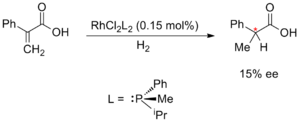William Standish Knowles facts for kids
Quick facts for kids
William Standish Knowles
|
|
|---|---|
 |
|
| Born | June 1, 1917 |
| Died | June 13, 2012 (aged 95) Chesterfield, Missouri, U.S.
|
| Education | Harvard University (AB) Columbia University (PhD) |
| Known for | Chiral phosphine ligands that proved effective in the enantioselective synthesis of L-DOPA |
| Awards | Nobel Prize in Chemistry (2001) |
| Scientific career | |
| Fields | Chemistry |
| Institutions | Thomas and Hochwalt Laboratories Monsanto Company |
| Thesis | A preliminary investigation of the constituents of Astragalus wootoni. Β-substituted-Δα, Β-butenolides of the naphthalene, indene and norcholane series (1942) |
| Doctoral advisor | Robert Elderfield |
William Standish Knowles (born June 1, 1917 – died June 13, 2012) was an American chemist. He was born in Taunton, Massachusetts. Knowles was one of the scientists who won the 2001 Nobel Prize in Chemistry. He shared half of the prize with Ryōji Noyori for their important work in a field called asymmetric synthesis. Specifically, his award was for his discoveries in hydrogenation reactions. The other half of the prize went to K. Barry Sharpless for his work on oxidation reactions.
Becoming a Chemist
Knowles went to Berkshire School in Sheffield, Massachusetts. He was a top student there. After finishing school, he got into Harvard University. However, Knowles felt he was too young for college. So, he spent another year at Phillips Academy in Andover, Massachusetts. At the end of that year, he won his first chemistry award, the $50 Boylston Prize.
After his extra year of prep school, Knowles went to Harvard. He studied chemistry, focusing on organic chemistry. He earned his first degree in 1939. Then, he went to Columbia University for his advanced studies.
Awards and Honors
William Knowles received several important awards for his scientific work:
- 1983 Chemical Pioneer Award from the American Institute of Chemists
- 2001 Nobel Prize in Chemistry
- 2008 Peter H. Raven Lifetime Achievement Award, from the Academy of Science, St. Louis.
His Nobel Prize Work
William Knowles shared half of the Nobel Prize in Chemistry in 2001 with Ryōji Noyori. They won for their "work on chirally catalysed hydrogenation reactions." The other half of the prize went to K. Barry Sharpless. He was recognized for creating new ways to do catalytic asymmetric oxidations.
Knowles helped create one of the first special catalysts for asymmetric hydrogenation. Imagine molecules can be "left-handed" or "right-handed," like your hands. This property is called "chirality." Most chemical reactions make an equal mix of both "hands." Knowles found a way to make mostly one "hand" of a molecule. He did this by changing parts of a common catalyst called Wilkinson's catalyst. He replaced some parts with "chiral" parts called phosphine ligands. This new catalyst helped make specific "handed" molecules.
Knowles was also the first to use this special type of catalysis in factories. While working for the Monsanto Company, he developed a method to make L-DOPA. This is an important medicine used to treat Parkinson's disease. He used a special chemical part called DIPAMP to make sure the L-DOPA had the correct "handedness" needed for the medicine to work.
Personal Life
After he retired in 1986, William Knowles lived in Chesterfield, Missouri. He enjoyed restoring native prairie grasses on a large farm that his wife had inherited. He was married to his wife, Nancy, for 66 years. They had four children: Elizabeth, Peter, Sarah, and Lesley. He also had four grandchildren. William Knowles passed away in Chesterfield on June 13, 2012, at the age of 95. He and his wife had decided that their farm would become a city park after they were gone.
See also
 In Spanish: William S. Knowles para niños
In Spanish: William S. Knowles para niños


